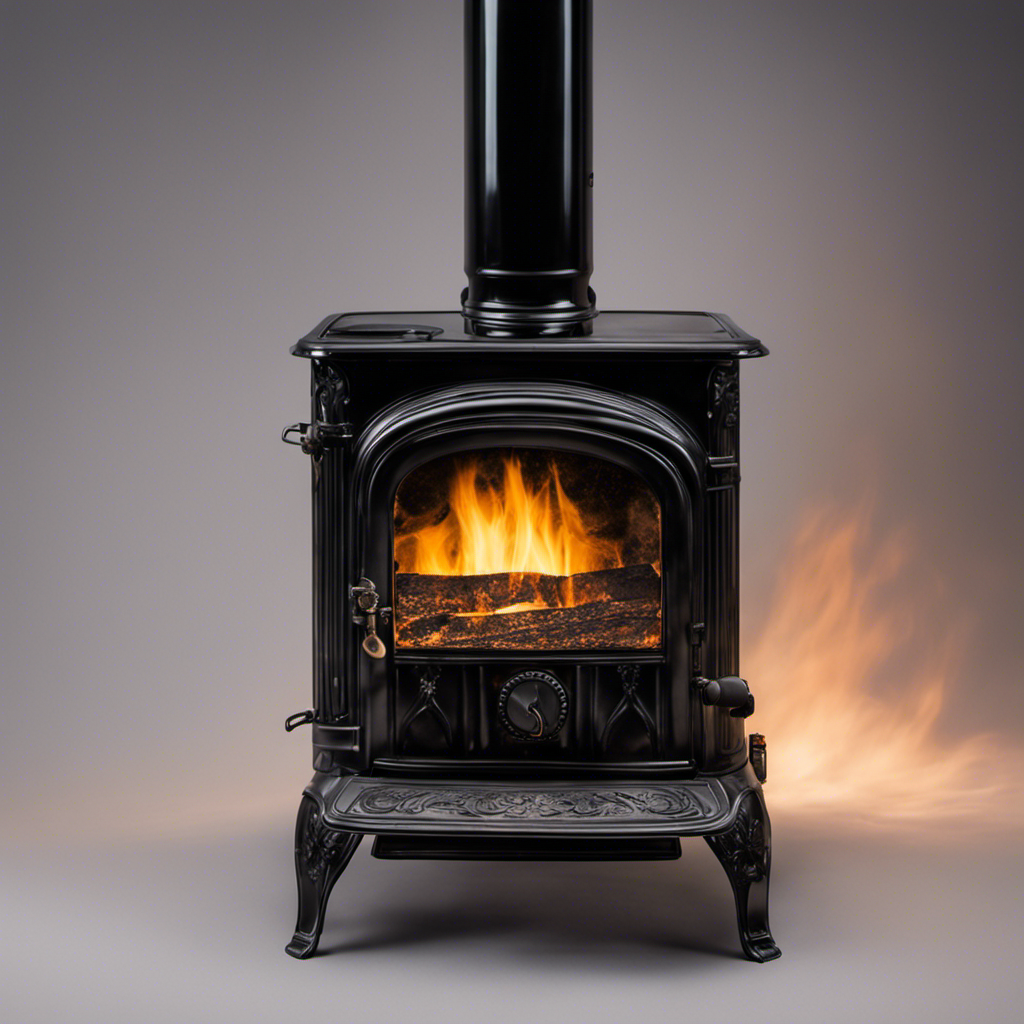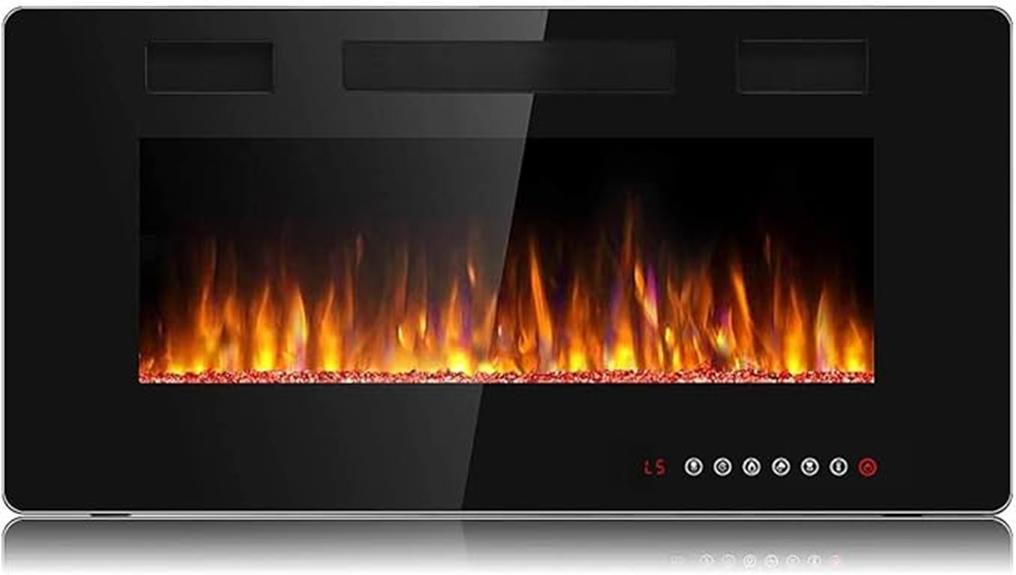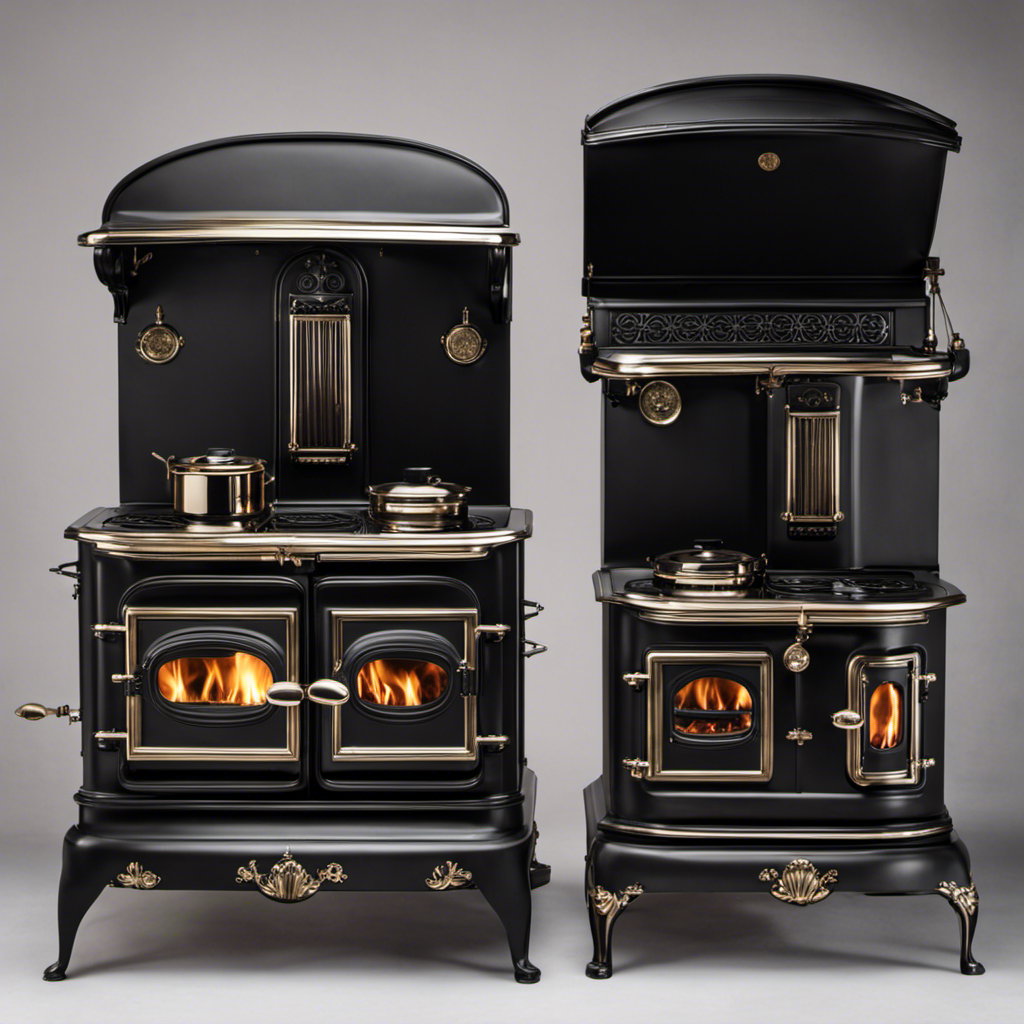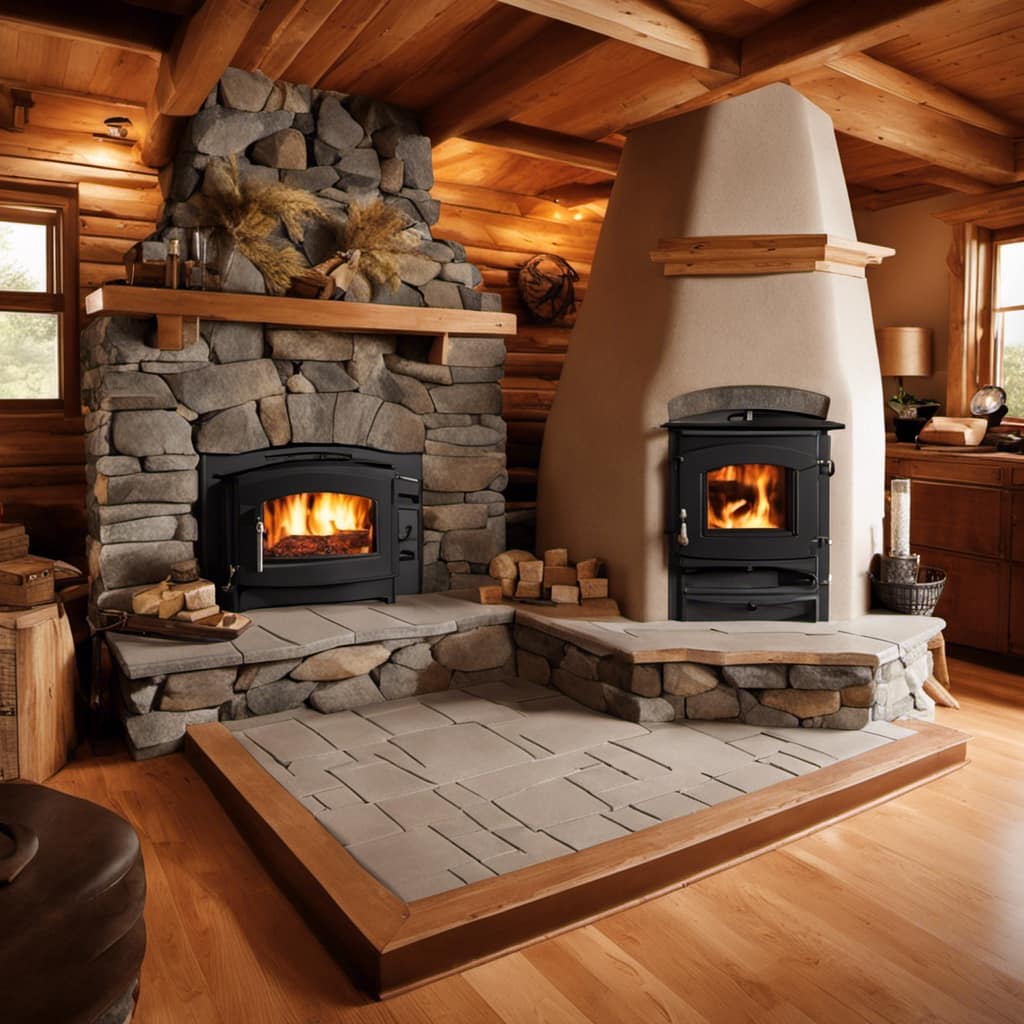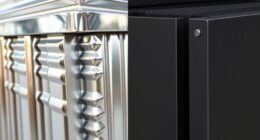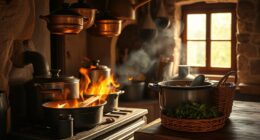I often question why the glass on my beloved wood-burning stove frequently gets covered in black soot, as someone who deeply values this appliance.
Delving into the depths of combustion, fuel quality, and air-to-fuel ratios, I’ve uncovered the secrets behind this phenomenon.
Join me on this technical journey as we explore the role of temperature and draft, and discover effective maintenance and cleaning tips.
Prepare to unlock the mysteries of why wood stove glass turns black, and gain a deeper understanding of your trusty heating companion.
Key Takeaways
- Combustion of wood in a wood stove can result in black residue on the glass surface.
- The black residue is caused by incomplete combustion, which occurs when there isn’t enough oxygen available.
- Wet or green wood with high moisture content leads to inefficient combustion and increased production of soot and creosote.
- Proper ventilation, airflow control, insulation, and chimney design are important for efficient combustion and preventing black residue buildup.
The Nature of Combustion
I’m fascinated by the nature of combustion and how it affects the blackening of wood stove glass.
Combustion is a chemical process that occurs when a fuel, such as wood, reacts with oxygen in the presence of heat. Incomplete combustion, which is common in wood stoves, happens when there isn’t enough oxygen available. This results in the production of smoke, which contains various particles and gases.
When the smoke comes into contact with the glass surface, it can leave behind a black residue. This residue is composed of carbon and other byproducts of the incomplete combustion process.
The blackening of wood stove glass is a clear indicator of inefficient burning and the need for proper air supply to achieve complete combustion.
Impact of Fuel Quality
The quality of fuel directly impacts the efficiency of combustion and the amount of black residue that builds up on wood stove glass. One of the main factors affecting fuel quality is the moisture content.
Wet or green wood contains a high level of moisture, which hinders the combustion process. The water in the wood needs to be evaporated before the actual burning can occur, resulting in less efficient combustion. This not only reduces the heat output but also increases the production of soot and creosote, leading to the black residue on the glass.
Properly seasoned wood, on the other hand, has been dried to a moisture content of around 20% or less, making it ideal for efficient burning. It’s crucial to use properly seasoned wood to ensure optimal combustion and minimize the buildup of black residue on the glass of wood stoves.
Influence of Air-to-Fuel Ratio
An important factor in achieving efficient combustion is maintaining a proper air-to-fuel ratio. The effect of ventilation and the importance of proper airflow cannot be overstated when it comes to combustion efficiency. The table below highlights the impact of different air-to-fuel ratios on the combustion process:
| Air-to-Fuel Ratio | Result |
|---|---|
| Too Rich (Excess Air) | Incomplete combustion, wasted fuel, increased emissions |
| Stoichiometric (Ideal Ratio) | Complete combustion, maximum energy release, minimal emissions |
| Too Lean (Insufficient Air) | Incomplete combustion, decreased energy release, increased emissions |
Achieving the ideal air-to-fuel ratio is crucial to ensure efficient combustion and minimize environmental impact. The proper amount of air allows for complete combustion, while excessive or insufficient air can lead to wasted fuel and increased emissions. This highlights the significance of proper ventilation and airflow control in achieving optimal combustion performance.
As we delve further into the role of temperature and draft in the combustion process, we will see how these factors interact with the air-to-fuel ratio to influence combustion efficiency.
Role of Temperature and Draft
Maintaining the proper temperature and draft is essential for optimal combustion performance. When it comes to wood stoves, there are two key factors that play a significant role in achieving this: the effect of insulation and the influence of chimney design.
Let’s delve into these factors and understand their importance in maintaining a clean and efficient wood stove operation.
-
Effect of insulation: Insulation plays a crucial role in keeping the heat inside the combustion chamber. With proper insulation, the stove can reach and maintain higher temperatures, promoting efficient combustion and reducing the production of harmful byproducts.
-
Influence of chimney design: The design of the chimney directly affects the draft of the wood stove. A well-designed chimney ensures proper air circulation and exhaust, allowing for a consistent supply of oxygen to the fire. This helps in achieving complete combustion and prevents the build-up of soot and creosote in the chimney.
Maintenance and Cleaning Tips
I should regularly clean out the ashes from the wood stove to prevent any blockages in the chimney and ensure efficient operation. By doing so, I can also minimize the buildup of soot on the glass, which can make it appear black and reduce the visibility of the flames.
To effectively clean the glass, there are several techniques that can be employed. One method is to use a mixture of vinegar and water, which can be sprayed onto the glass and then wiped away with a soft cloth. Another option is to use a specialized glass cleaner that’s designed specifically for wood stoves. These cleaners are often formulated to remove soot and other stubborn stains without damaging the glass surface. It’s important to follow the manufacturer’s instructions when using these cleaners to ensure safety and effectiveness.
Additionally, regularly cleaning the stove’s flue and chimney can help prevent the buildup of soot and other debris, further reducing the likelihood of blackened glass.
To summarize, regular maintenance and cleaning of the wood stove, including cleaning out ashes and employing appropriate glass cleaning techniques, are essential for preventing soot buildup and ensuring the glass remains clean and clear.
Frequently Asked Questions
Can I Use Any Type of Wood in My Wood Stove?
I prefer using seasoned wood in my wood stove because it burns more efficiently and produces less creosote buildup. Different types of wood also affect stove performance, with hardwoods generally providing longer-lasting and hotter fires.
How Often Should I Clean the Glass on My Wood Stove?
I clean my wood stove glass regularly to prevent blackening. Here are some tips: use a specialized glass cleaner, avoid burning wet or unseasoned wood, and keep the air vents properly adjusted.
What Should I Do if the Glass on My Wood Stove Becomes Cracked or Broken?
If the glass on my wood stove becomes cracked or broken, I should follow these steps to safely replace it: 1) Turn off the stove and let it cool completely. 2) Remove the old glass and clean the area. 3) Install the new glass following the manufacturer’s instructions.
Is It Normal for the Glass on a Wood Stove to Turn Completely Black?
It’s common for wood stove glass to turn black due to the accumulation of soot and creosote. To prevent blackening, ensure proper air flow, burn dry wood, and clean the glass regularly with approved cleaning products.
Are There Any Specific Cleaning Products I Should Use to Clean the Glass on My Wood Stove?
To prevent the glass on your wood stove from getting black, use specific cleaning products designed for wood stove glass. Regularly clean the glass with these products to maintain its clarity and prevent buildup.
Are Black Stove Glass and Wood Stove Gasket Related?
When it comes to black stove glass and wood stove gasket, understanding their relationship is crucial. While black stove glass provides an aesthetic appeal and insulation, the measuring wood stove gasket ensures efficient sealing and prevents air leakage. Both components play essential roles in maintaining a safe and functional wood stove.
Conclusion
In conclusion, the blackening of wood stove glass can be attributed to several factors. These factors include the nature of combustion, fuel quality, air-to-fuel ratio, temperature, and draft. Understanding these influences can help users maintain a clean and efficient wood stove.
By ensuring the proper air-to-fuel ratio, users can minimize the blackening of wood stove glass. This can be achieved by adjusting the stove’s air vents to allow for optimal combustion. Additionally, using high-quality fuel, such as well-seasoned hardwood, can also help reduce blackening.
Regular cleaning and maintenance of the wood stove is essential in preventing excessive blackening. Users should regularly remove any ash or debris from the stove’s firebox and clean the glass using appropriate cleaning products. This will help to remove any soot or creosote buildup and keep the glass looking clear.
In summary, by understanding the factors that contribute to blackening, and implementing proper maintenance techniques, users can prevent excessive blackening and enjoy the warmth and beauty of a well-functioning wood stove. Remember, a little TLC goes a long way in keeping your wood stove glass looking crystal clear.
Growing up surrounded by the vast beauty of nature, Sierra was always drawn to the call of the wild. While others sought the comfort of the familiar, she ventured out, embracing the unpredictable and finding stories in the heartbeat of nature.
At the epicenter of every remarkable venture lies a dynamic team—a fusion of diverse talents, visions, and passions. The essence of Best Small Wood Stoves is crafted and refined by such a trio: Sierra, Logan, and Terra. Their collective expertise has transformed the platform into a leading authority on small wood stoves, radiating warmth and knowledge in equal measure.

